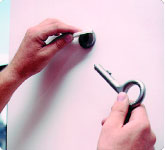Fall arrest & restraint protection.

Safety eyebolts are installed inside or outside a building to provide a single anchorage point for fall arrest and restraint.
They are easy to install into suitable load-bearing elements of the building. They can be concealed in access boxes in raised flooring and also through dry lined walls by using a cantilever socket in the cavity.
They are available in a range of different finishes including galvanised steel, stainless steel and white nylon coated.
Eiger Safety eyebolts allow you to meet BS8213 Part 1 1991 guidelines for safe reach limits for window cleaners.

PushLock
The Latchways PushLock safety eyebolt provides a discreet yet highly effective alternative to unsightly conventional eyebolts. Whilst conventional eyebolts meet the safety need, their lack of aesthetic consideration can impair the visual characteristics of the office, hotel or housing environment in which they are installed. The pleasing design and assured safety of the Latchways PushLock overcomes the problem.
The Latchways PushLock socket is a permanent anchor installed into the structure of the building. The socket is suitable for installation in a variety of materials including brickwork, concrete and steelwork. Sockets are available for installation in cavity walls and suspended ceilings. The PushLock socket is discreetly capped when not in use.
- Socket caps are available in a prestige brass finish, stainless steel and a range of colours.
- When required, the worker inserts a PushLock eyebolt into the socket to create a secure anchor.
- Insertion or removal of the PushLock eyebolt is a two handed operation, which therefore makes accidental removal impossible.
- The PushLock socket and eyebolt are tested to 22 kN.
- PushLock has been tested to EN795:1996 and meets all appropriate international standards including the EC Declaration of Conformity.

KeyAnka
The KeyAnka safety eyebolt offers a removable unobtrusive solution to traditional eyebolts in more prestigious buildings. The permanently installed steel anchor socket is concealed by a flush fitting white plastic cover, which blends in with most interior designs. Equipped with the KeyAnka eyebolt at the end of his lanyard the operator uses a simple ‘key’ action with sprung locking movement to provide a fast and safe attachment. The eyebolt is able to rotate 180 degrees whilst still attached to the socket to provide the best orientation in the event of fall arrest situation and can only be removed by five simple, separate but deliberate, sequential movements.
Installation
Safety eyebolts should only be installed by suitably trained and qualified personnel. They should be located so that an operative can connect to the eyebolt from a position where they are not at risk of a fall. They must only be fixed into a suitable load-bearing element of the building. This excludes brickwork parapets, infill panels and areas below windows or within 280mm of an edge in brickwork or 150mm in concrete. All eyebolts are installed in accordance with the recommendations set out in BS Code of Practice 7883:2005 conforming to BS EN795
Testing & Maintenance
By law, single point anchors must be tested to 6kN and inspected and certified a minimum of once every 12 months by a suitably qualified person.





